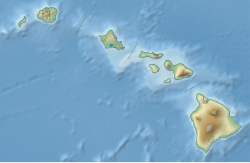1868 Hawaii earthquake
| Date | April 2, 1868 |
|---|---|
| Magnitude | 7.9 ML |
| Epicenter | 19°12′N 155°30′W / 19.2°N 155.5°WCoordinates: 19°12′N 155°30′W / 19.2°N 155.5°W |
| Areas affected | Hawaii |
| Total damage | Limited |
| Max. intensity | X (Extreme) |
| Tsunami | Yes |
| Casualties | 31–77 killed |
The 1868 Hawaii earthquake was the largest recorded in the history of Hawaiʻi island, with an estimated magnitude of 7.9 on the Richter magnitude scale and a maximum Mercalli intensity of X (Extreme). The earthquake occurred at 4 p.m. local time on April 2, 1868 and caused a landslide and tsunami that led to 31–77 deaths. The aftershock sequence for this event has continued up to the present day.
The island of Hawaiʻi (commonly called the "Big Island") is the currently active volcanic center of the Hawaiian Islands formed over the Hawaii hotspot. The two active volcanoes on the Big Island are Kīlauea and Mauna Loa with a newer submarine volcano forming the Loihi Seamount to the southeast of the island. Continued growth of the southeastern part of the island is accompanied by major slumping and southeastward movement of the flanks of the two volcanoes.
This flank displacement is linked to extension within the rift zones associated with both of the active volcanoes, the Mauna Loa and Kīlauea rifts. From the interpretation of seismic reflection data, it has been proposed that the southeastward displacement takes place on a decollement surface near the top of the oceanic crust. The slumping is thought to affect only the upper part of the flank as the amount of shortening observed in the toe thrust zone is much larger than that observed in the extensional faults associated with the slumps, but matches well with estimates of extension within the volcanic rift systems.
The Hilina Slump is the largest of the active slumps around the Hawaiian islands. The 'backscarp' to the slump is formed by the Hilina extensional fault system, which is known to have moved in both the 1868 event and the 1975 Kalapana earthquake.
...
Wikipedia

